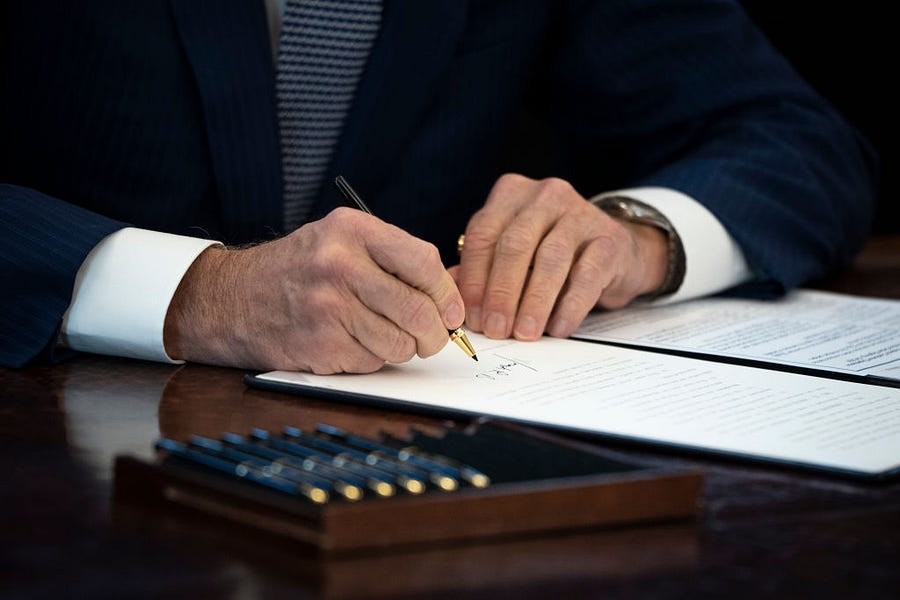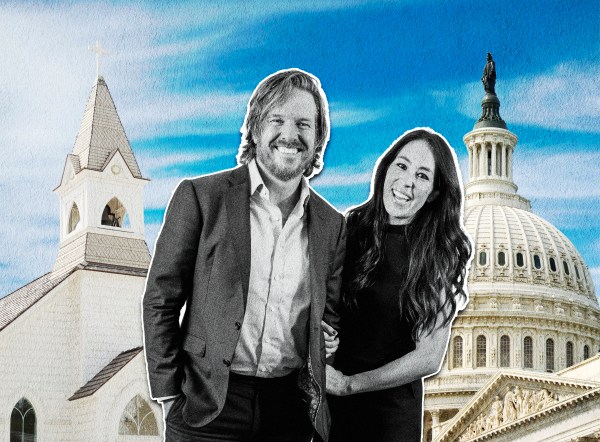In the course of his nominally “centrist” 2020 campaign, President Biden embraced a whole series of radical, bad ideas for higher education. Whether due to old-fashioned realpolitik, the stylings of woke policy wonks on a somnolent staff, or an attempt to court the party’s over-caffeinated Twitter base, Biden embraced “free” college, loan forgiveness, Title IX extremism, and much else.
Specifically, Biden pledged to make two years of community college free for all students and to forgive all undergraduate "tuition-related" student debt for those earning up to $125,000 a year. The price tag was extraordinary. Biden’s free college and student loan proposals alone were estimated to cost $2.9 trillion over a decade. He also vowed to restore Obama-era Title IX rules that denied due process to students accused of sexual misconduct, yielded campus-run kangaroo courts, and led to hundreds of lawsuits from accused students on grounds of due process and discrimination. The DeVos Department of Education had restored due process in 2020 after a formal, lengthy rule-making process.
Well, after a year of fumbling, Biden has failed to achieve any of these goals. This is good for the nation, for taxpayers, and for students. Even if Biden can persuade Sen. Joe Manchin to resurrect something from the wreckage of Build Back Better, his “free college” and debt forgiveness proposals seem safely interred for at least the next few years. But it isn’t all good news: Unable to move legislation through a Democratic Congress, Biden has increasingly turned to piecemeal pandering by executive order while ignoring easy opportunities to sound useful notes and solve practical problems.
Let’s start by digging deeper into Biden’s failures to move his agenda.
Biden’s “free” community college proposal did make it as far as the fall’s initial $3.5 trillion version of Build Back Better. The proposed federal-state “partnership” (a delicate description of Obamacare-style federalism) prompted a frenzy of enthusiasm in the higher ed world, full of cart-before-horse conversation about how to spend the windfall. But, when Sens. Manchin and Kyrsten Sinema insisted that they’d meant it when they termed the $3.5 trillion price tag too high, free college got tossed overboard.
Loan forgiveness didn’t make it that far. On the campaign trail, Biden promised, “I’m going to eliminate your student debt if you come from a family [making less] than $125,000 and went to a public university” and “I’m going to make sure everyone gets $10,000 knocked off of their student debt.” Thus far, though, the White House hasn’t moved any actual legislative proposal on this count. Furthermore, Biden has responded to the woke left’s demands to order the secretary of education to discharge student debt by kinda, sorta explaining that he lacks the requisite authority (alert readers may find this eerily reminiscent of his Hamlet act regarding the eviction moratorium or federal vaccine mandates).
Of course, it’s unclear just what problems the trillions proposed for higher education are intended to solve. Indeed, the College Board, which annually tracks college pricing and aid, reports that generous public subsidies mean that the net cost of community college (i.e., tuition and fees minus student aid) has been $0 (or less!) for more than a decade. The Texas Public Policy Foundation’s Andrew Gillen has drily noted, “We’ve had de facto free community college in this country since 2009-10.”
As for loans, generous financial aid policies mean that inflation-adjusted net annual tuition increased less than $600 between 1996 and 2016 for low- and middle-income students. In fact, a 2014 Brookings Institution Analysis reported that, since 1992, median borrowers have consistently spent about 4 percent of their monthly income repaying student loans. By income, the top 40 percent of households account for 75 percent of student loan payments; half of all student debt is held by households in which someone holds a graduate degree.
For the most part, loan forgiveness is a subsidy to the affluent and a solution to a non-problem, one that rewards heavy borrowers at the expense of those who didn’t attend college, hustled to minimize borrowing, or who’ve paid off their loans. This makes it especially egregious that Biden has turned to executive orders to push piecemeal giveaways. Early in the pandemic, back before Washington had taken to mailing out trillions in federal aid, the Trump administration took the dramatic step of adopting a blanket pause on loan repayments—freezing the accrual of interest and suspending payment. Since that time, what was initially billed as a temporary stopgap has been continuously extended. In August, Biden announced one last, "final” pause on student loan repayment that would end January 31. So much for that. Biden recently announced that the freeze will be extended into May, meaning it’s been two years since borrowers—whatever their financial circumstances—were expected to make loan payments. As of last June, the cost (originally estimated to be $15 billion) already exceeded $68 billion. It’s a safe bet that the total cost will eventually exceed $100 billion.
Biden has also provided loan relief via a series of executive actions. The administration has forgiven $5.8 billion to disabled borrowers, another $1.3 billion to borrowers who had failed to comply with monitoring rules, and aggressively used Borrower Defense to Repayment to forgive billions to borrowers who attended an institution with even isolated evidence of “misleading promotional materials.” Biden also unilaterally expanded the Public Service Loan Forgiveness (PSLF) program, which eventually forgives loans to borrowers who take jobs in the public or nonprofit sector. The Department of Education estimates that the PSLF expansion could ultimately reduce loans for up to 550,000 borrowers. It projects the cost of all this thus far to be $11.5 billion, though the PSLF expansion means the final tally will likely be tens of billions more.
As for Title IX, Biden’s promise to undo Trump-era reforms stumbled on the fact that the DeVos Department of Education (unlike her predecessor’s) actually went through the full federal rule-making process. Thus, it’ll take a while to restore the Obama-era star chambers, in which colleges were directed to use the lowest possible standard of evidence, deny defendants the chance to have a representative question their accuser, and even bar the accused from seeing the charges leveled against them. True to form, though, Biden’s team hasn’t allowed mere legal processes to stop them. On his first day in office, Biden issued an executive order extending the 2020 Supreme Court ruling in Bostock v. Clayton County (regarding employment protections for gay and transgender employees) to Title IX. In June, the Department of Education declared in a Notice of Interpretation that it henceforth reserved the right to take action against colleges that use biological sex to organize dormitories, locker rooms, or sports teams.
While Biden has been fiddling with his pen and phone, he’s missed golden opportunities to speak for the nation’s broad middle on higher education in a way that would be exceedingly healthy (and that could do much to burnish his waning centrist cred).
For starters, given Biden’s concerns about college affordability and student debt, it’s remarkable that he hasn’t been willing to challenge colleges to tackle administrative bloat and rein in their costs. After all, this is a president who has enthusiastically blamed profiteering companies for runaway prices. Biden might’ve coupled his big spending plans with a challenge to colleges to curb their costs, which have substantially exceeded the rate of inflation for decades. Indeed, given that many colleges have been remote for a chunk of the Biden presidency, Amtrak Joe might’ve folksily asked why it costs so much to educate a kid in their parents’ basement. Sincere or not, this would’ve provided a veneer of fiscal responsibility and a common sense complement to his grand new spending plans.
Biden also might’ve taken the lead in urging colleges to help guide the nation back to the normalcy he has championed. After all, colleges mostly serve a relatively young demographicat limited risk from COVID-19. Biden might’ve argued that, aided by billions in emergency federal aid, CDC guidance, high rates of vaccination, and sensible mitigation policies, colleges should be offering in-person classes and doing everything they can to provide students with healthy social interactions. And yet, even as Michigan State, Yale, UCLA, Duke, and many other campuses are going virtual or embracing draconian lockdowns like it was spring 2020, Biden hasn’t used his bully pulpit to push back or even explain that his own efforts have made such measures unnecessary and unwise.
As far as student loans, Biden could have tackled some of the low-hanging bipartisan fruit. For instance, forgiveness and loan freezes aside, existing income-based repayment (IBR) options make it possible for borrowers to pause payments when they’re out of work and limit repayment to a manageable portion of a borrower’s income. Unfortunately, the existing programs are balky, confusing, and not customer-friendly. There are plenty of good ideas on how to fix that. Streamlining and overhauling the IBR framework would be greeted by most higher ed authorities, on the center-left, in the middle, and even on the right, as a terrific and timely step forward.
And then, of course, Biden has been presented with a grand Nixon-to-China opportunity to use his bully pulpit to push back on campus intolerance and censoriousness. After all, in 2017, at the University of Delaware, Biden thundered, “We hurt ourselves badly when we don’t allow the speech to take place . . . The First Amendment is one of the defining features of who we are in the Bill of Rights. And to shut it down in the name of what is appropriate is simply wrong.” A Democratic president visiting a campus to repeat just that message would be an enormously important, healthy thing. Yet, since taking office, Biden has assiduously avoided addressing concerns about campus speech—even as surveys find that troubling numbers of students deem it okay to use violence to shut down speech.
All in all, Biden’s higher education story in year one is mostly a blank page. Given the cost of his dubious solutions to non-problems, that’s cause for relief. And yet, it means that Biden has left a tremendous amount of good undone, at a time when the nation could benefit mightily from a Democratic president urging the nation’s colleges to get their house in order.
Frederick M. Hess is the director of education policy studies at the American Enterprise Institute.






Please note that we at The Dispatch hold ourselves, our work, and our commenters to a higher standard than other places on the internet. We welcome comments that foster genuine debate or discussion—including comments critical of us or our work—but responses that include ad hominem attacks on fellow Dispatch members or are intended to stoke fear and anger may be moderated.
With your membership, you only have the ability to comment on The Morning Dispatch articles. Consider upgrading to join the conversation everywhere.